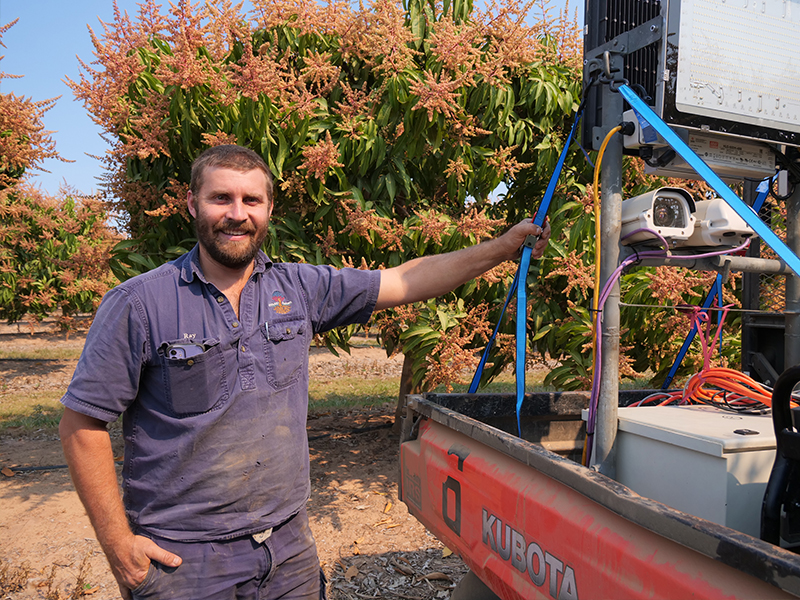
The investment Multi-scale monitoring tools for managing Australian tree crops is a collaborative piece of work funded through the Australian Government’s Rural R&D for Profit initiative. The overarching program is continuing to develop, trial and extend technology-based crop mapping and monitoring tools to help growers predict fruit quality and yield, and monitor tree health – including in the early detection of pest and disease outbreaks.
This project involves some nine sub‑projects sitting under an overarching project, with a variety of teams all being led by Hort Innovation.
Meet Raymond, mango grower from Dimbulah, North Queensland
Raymond Courtice is a second-generation mango grower from Dimbulah, north Queensland who works at his family business, Ontario Group, with his father David. Ontario Group is a family-run business, revolving around the production of calypso mangoes as well as citrus to diversify and utilise their staff and equipment throughout the year. David was one of the first commercial growers of calypso mangoes in the late 1990s and they have stuck with the variety ever since. The Ontario mango orchards are spread across two locations of 400ha.
Why did you participate in this program?
When Kerry Walsh from Central Queensland University told me he was working on creating a unit that would count your crop load and give you an accurate result of every location within your farm, my ears pricked.
Standard practice is manual fruit counts averaging across the block to give you your expected crop load for the season.
During the 2019/20 season, we experienced frost with temperatures dipping to minus five degrees, damaging 70 per cent of our crop. At this point we had frost protection fans installed within the orchard which usually gave 100 per cent protection for short stints between 0 to -3 degrees, but at -5 degrees this was not the case.
So, when the opportunity was presented to trial crop forecasting using the machine vision rig on my orchard, I was 100 per cent in for using technology to give me accurate data on how much damage the frost had done to my crop load. Accurate crop forecasting data is invaluable for planning for harvest and marketing.
How does the technology work?
The machine vision rig, which is linked to GPS, is mounted on a vehicle and the whole orchard can be ‘photographed’. We have found that every three rows is the intensity vs accuracy ‘sweet spot’.Data is calibrated with manual fruit counts – a similar requirement to previous yield forecasting, and then the location and imagery data is processed to generate a ‘heat map’ of yield across the orchard.
What did you learn?
What this technology offers over other yield estimation tools and forecasting strategies, is a picture of spatial variability in yield across the orchard. We could clearly see where our frost protection could not reach or protect and there was no fruit, ranging to close to the frost fans where the loss was only about 25 per cent.
While my initial interest in trialling the equipment was to understand the scale of the frost damage, the experience showed me that the technology could provide useful data that was impossible to get with manual forecasting practices.
For example, you can make the wrong calls on fruit profile – and then your water and nutrition management can result in fruit ballooning. The production forecast maps generated using this equipment, gives information not otherwise available to manage the orchard to optimise production.
What this now allowed me to see and understand was instead of treating whole zones in the orchard, I was able to tailor nutrition and irrigation to target certain blocks for domestic and export markets as I had a full understanding of predicted yield, size, profile and entire orchard expected fruit count.
What has been the benefit?
The immediate benefit of using this technology is that we can now tailor our management practices to ensure we have ‘got it right’ for the fruit that survived the frost and minimise further losses due to fruit quality. It also gave us information that enabled us to increase the number of frost protection fans we needed to have for full coverage of the orchard.
Using the imaging rig is now an operation that I have adopted post-fruit drop and pre-harvest to monitor and manage crop load, nutrition and water, and pre‑forecast for our marketers, exporter, freight, carton and labour companies. It gives me assurance that what I believe we are looking at harvesting is actually on the farm. Being able to have this sort of tool becomes an advantage in this era of farming.
Participating in this project has given us a tool we now couldn’t see our operation work without.
